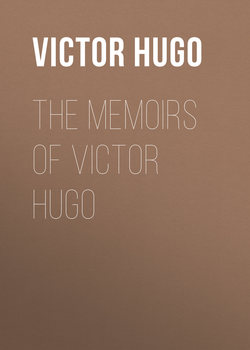Читать книгу The Memoirs of Victor Hugo - Victor Hugo, Clara Inés Bravo Villarreal - Страница 8
VISIONS OF THE REAL
V. THE EASTER DAISY. May 29, 1841
ОглавлениеA few days ago I was passing along the Rue de Chartres.2 A palisade of boards, which linked two islands of high six-story houses, attracted my attention. It threw upon the pavement a shadow which the sunshine, penetrating between the badly joined boards, striped with beautiful parallel streaks of gold, such as one sees on the fine black satins of the Renaissance. I strolled over to it and peered through the cracks.
This palisade encloses the site on which was built the Vaudeville Theatre, that was destroyed by fire two years ago, in June, 1839.
It was two o’clock in the afternoon, the sun shone hotly, the street was deserted.
A sort of house door, painted grey, still ornamented with rococo carving and which a hundred years ago probably was the entrance to the boudoir of some little mistress, had been adjusted to the palisade. There was only a latch to raise, and I entered the enclosure.
Nothing could be sadder or more desolate. A chalky soil. Here and there blocks of stone that the masons had begun to work upon, but had abandoned, and which were at once white as the stones of sepulchres and mouldy as the stones of ruins. No one in the enclosure. On the walls of the neighbouring houses traces of flame and smoke still visible.
However, since the catastrophe two successive springtides had softened the ground, and in a corner of the trapezium, behind an enormous stone that was becoming tinted with the green of moss, and beneath which were haunts of woodlice, millepeds, and other insects, a little patch of grass had grown in the shadow.
I sat on the stone and bent over the grass.
Oh! my goodness! there was the prettiest little Easter daisy in the world, and flitting about it was a charming microscopical gnat.
This flower of the fields was growing peaceably and in accordance with the sweet law of nature, in the open, in the centre of Paris, between a couple of streets, two paces from the Palais-Royal, four paces from the Carrousel, amid passers-by, omnibuses and the King’s carriages.
This wild flower, neighbour of the pavement, opened up a wide field of thought. Who could have foreseen, two years ago, that a daisy would be growing on this spot! If, as on the ground adjoining, there had never been anything but houses, that is to say, proprietors, tenants, and hail porters, careful residents extinguishing candle and fire at night before going to sleep, never would there have been a wild flower here.
How many things, how many plays that failed or were applauded, how many ruined families, how many incidents, how many adventures, how many catastrophes were summed up in this flower! To all those who lived upon the crowd that was nightly summoned here, what a spectre this flower would have been had it appeared to them two years ago! What a labyrinth is destiny and what mysterious combinations there were that led up to the advent of this enchanting little yellow sun with its white rays. It required a theatre and a conflagration, which are the gaiety and the terror of a city, one of the most joyous inventions of man and one of the most terrible visitations of God, bursts of laughter for thirty years and whirlwinds of flame for thirty horn’s to produce this Easter daisy, the delight of a gnat.
2
The little Rue de Chartres was situated on the site now occupied by the Pavilion de Rohan. It extended from the open ground of the Carrousel to the Place du Palais-Royal. The old Vaudeville Theatre was situated in it.
